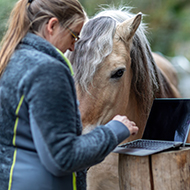DNA test detects Lyme disease in horses

"The method is like having a special, specific 'fishhook' that only grabs Borrelia DNA and not the DNA of other microbes, nor the DNA of the host" - Prof Steven Schutzer.
A team of scientists from New Jersey have developed an advanced DNA test capable of identifying Lyme disease in a sick horse.
Professor Steven Schutzer, a professor of medicine at Rutgers University, and his team used their “genomic hybrid capture assay” to detect the disease agent – Borrelia burgdorferi – in a sample of the horse's spinal fluid.
The test, described in the Journal of Veterinary Diagnostic Investigation, works by isolating DNA from the microorganism causing the disease.
Schutzer explained: "The method is like having a special, specific 'fishhook' that only grabs Borrelia DNA and not the DNA of other microbes, nor the DNA of the host (animal or human). Detecting DNA of the disease is a direct test, meaning we know you have active disease if it's circulating in the blood or spinal fluid.”
Lyme disease is the most common vector-borne illness in the US, transmitted to humans and animals by ticks. In horses, symptoms can include chronic weight loss, lameness and low-grade fever.
Usually, when a Lyme disease infection is suspected, antibody tests are administered. However, in the case of an 11-year-old Swedish warmblood mare, a standard PCR and antibody test did not detect an infection.
It was Schutzer's advanced test that ultimately detected the pathogen, allowing Lyme disease to be diagnosed and successfully treated.
Professor Thomas Divers, a veterinary surgeon who led the equine team on the paper, said: "The diagnosis of Lyme neuroborreliosis (Neurologic Lyme disease) in horses is rarely confirmed antemortem and has frustrated veterinarians for years.
“This is a very promising technique. Focused treatment against B. burgdorferi administered in this case resulted in the horse's complete athletic recovery."



 With Strangles Awareness Week just around the corner (5-11 May), vets are being encouraged to share a survey about the disease with their horse-owning clients.
With Strangles Awareness Week just around the corner (5-11 May), vets are being encouraged to share a survey about the disease with their horse-owning clients.